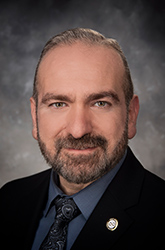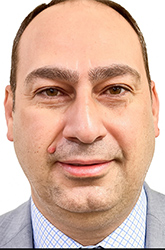TTUHSC Amarillo Internal Medicine Residency

TTUHSC Amarillo Internal Medicine Residency Program
Application Deadline | December 1, 2025
Next Start Date | July 1, 2026
The Internal Medicine Residency Program at TTUHSC-Amarillo remains fully accredited by the ACGME and continues to provide a robust training environment. The program includes thirteen residents at each level—interns, PGYII, and PGYIII—along with third- and fourth-year TTUHSC medical students who complete core rotations and electives in Internal Medicine. Patient care and teaching form the core of the program, with training centered at Northwest Texas Hospital, a 400-bed regional trauma and heart hospital, and the Thomas E. Creek VA Medical Center, which serves over 25,000 patients annually. Residents also gain experience in outpatient care at Texas Tech Physicians clinics and through partnerships with Texas Oncology, P.A.
Faculty consist of full-time, board-certified clinicians across general Internal Medicine and key subspecialties, complemented by community physicians for both clinical and didactic teaching. The curriculum features Morning Report, Grand Rounds, board review sessions, Journal Club, and simulation training at Sim Central. With procedural instruction led by Critical Care specialists and a strong didactic foundation, the program ensures well-rounded preparation. Notably, the ABIM Board pass rate has been 100% in four of the past five years. Beyond clinical skills, the program emphasizes professionalism, ethics, responsibility, and accountability, preparing residents for excellence in patient care and leadership.
Information for Applicants
Internal Medicine Residency Program: Applicant Information & Training Philosophy
- To promote a training experience that is broad-based, comprehensive, humane, and patient-centered. Our learning atmosphere should combine nurturing collegiality with a focus on excellence in medical knowledge and patient care.
- Our graduates should be capable of independently managing patients as primary care internists and as hospitalist, and should have background both in procedural skills and critical appraisal of evidence to compete for desirable fellowships. They should have ample experience in ambulatory and inpatient care, in general medicine as well as subspecialty practice. They should be knowledgeable, efficient, and safety-oriented, and should be comfortable caring for diverse patients, including veterans, patients with limited means and rural patients of West Texas.
- Our program strives to inculcate the core values of respect for diversity, humility, honesty, and resilience (resistance to burnout). Our residents should work to improve themselves and the healthcare system in commitment to life-long self-education and leadership.
The Department of Internal Medicine Residency Program only accepts applications through the Electronic Residency Application Service (ERAS). Information about the service may be obtained from your Dean's Office or from the American Association of Medical Colleges (AAMC). International medical graduates may obtain information about ERAS through the Educational Commission for Foreign Medical Graduates (ECFMG).
Resident Application Deadline is September 1, 2025.
Thank you for your interest in our Internal Medicine Residency Program. Click here to view our Applicant Information document.
Residency Benefits, Salaries, and Time Off
For all benefits and conditions of employment including information concerning leaves of absences and medical malpractice insurance, please visit the Amarillo Graduate Medical Education page.
Institutional Benefits
Salaries
- PGY-1: $56, 263
- PGY-2: $58,099
- PGY-3: $59,934
Department Benefits
Paid Vacation/Time Off
As a PGY-1 resident, you will receive 28 days (4 weeks) of leave time. As a PGY-2 and PGY-3, you will receive 35 days (5 weeks) of leave time.
** Note: All time off must be approved by the department 6-8 weeks in advance.
Books, Subscriptions, & Membership Dues
- Annual membership dues paid for American College of Physicians.
- A 3-year Subscription for ACP Digital MKSAP.
- Access to Up-to-Date through the TTUHSC Library at no charge
Residency Compensation, Leave, and Professional Resources
The TTUHSC-Amarillo Internal Medicine residency program operates under the Program Requirements for Resident Education in Internal Medicine, established by the ACGME. These are strictly followed. The Core Competencies of Patient Care, Medical Knowledge, Practice-Based Learning and Improvement, Interpersonal and Communication Skills, Professionalism, and Systems-Based Practice are stressed. Readers are encouraged to review this document on the ACGME website.
Our program year is made up of 13 blocks with each block containing 4 weeks.
The first-year resident, with the direct supervision and support of an upper-level resident and faculty attending physician, develops clinical diagnostic and medical management skills. Typical IM procedural skills are learned during the first year, including an introduction to placement of arterial lines, central lines, and catheters during the ICU rotation. All this supports advancement to the more independent performance and greater responsibility required during the second and third years. The intern is also expected pursue scholarly learning and, perhaps most importantly, to maintain the highest standard of personal and professional conduct.
- NWTH Ward – 16 weeks
- VAMC Ward – 12 weeks
- NWTH ICU – 6 weeks
- NWTH Night Shift – 4 weeks
- NWTH Nephrology – 4 weeks
- Cardiology – 2 weeks
- Anesthesia – 2 weeks
- Endocrinology – 2 weeks
- Hematology/Oncology – 2 weeks
- Pulmonary – 2 weeks
- One afternoon per week IM continuity Clinic.
The second-year resident, still with the support and supervision of the attending physician, further develops clinical diagnostic and medical management skills and assumes greater responsibility for the care of the patient. Added responsibility involves the direct supervision of the intern and medical student.
A continued high standard of personal professional ethics and humanistic qualities is required, including being a role model for others on the team. Further procedural skills are developed and supervised. Scholarly activity is encouraged.
- NWTH Ward – 8 weeks
- VAMC Ward – 8 weeks
- VAMC Night Shift – 4 weeks
- NWTH ICU – 8 weeks
- Ambulatory – 4 weeks
- Cardiology – 2 weeks
- Consultation – 4 weeks
- Electives – 14 weeks
- One afternoon per week IM continuity clinic.
The third-year resident builds upon the second year, developing further clinical competence and procedural skills, as well as a greater academic foundation. Although many duties in this year are similar to those of the preceding years, the third-year resident assumes greater responsibility, leadership, and supervisory capacity. Further specialty training via electives, more outpatient experience, and continued scholarly activities lead to the goal of becoming fully independent by the conclusion of residency. As s always, the highest personal and professional standards should be upheld; third-year residents, in particular, should be exemplary role models.
With input from all residents and faculty, third-year residents are selected as Chief Residents and assume additional responsibilities regarding schedules, conferences, and teaching.
- NWTH Ward – 8 weeks
- VAMC Ward – 4 weeks
- NWTH ICU – 4 weeks
- NWTH ICU Night Shift – 4 weeks
- Cardiology – 2 weeks
- NWTH ER – 4 weeks
- Neurology – 2 weeks
- Electives – 24 weeks
- One afternoon per week IM continuity clinic.
When viewed as a three-year whole, at least one-third of the training involves ambulatory experience, as mandated by the ACGME and in keeping with the trend in medicine toward greater outpatient care. Our clinics and hospitals, of course, have computer support with around the clock internet access to medical references and clinical support sites.
Our outpatient resident continuity clinic is equipped with a fully implemented electronic medical record. Residents will receive training to be able to provide comprehensive medical care for their patients in an otherwise "paperless" clinical setting.
The Internal Medicine Residency Program at TTUHSC-Amarillo continues full accreditation by Accreditation Council for Graduate Medical Education (ACGME).
The usual complement of Internal Medicine residents now includes thirteen Interns, thirteen PGYII and thirteen PGYIII. Third year TTUHSC medical students are involved in core rotations in Amarillo, typically eight or nine at a time in Internal Medicine; a similar number of fourth year students are present, pursuing various requirements and electives.
Patient service and teaching are the foundation of our mission. We achieve good patient volume and diversity via our two main teaching hospitals, Northwest Texas Hospital (NWTH) and the Veterans Administration Medical Center (VAMC). NWTH is a private 400-bed hospital but is also responsible for the indigent of the community and is our regional trauma center. Here we admit our own Texas Tech private patients, those from the Amarillo Hospital District's Wyatt Clinic, and those via the ER without a physician. The Thomas E. Creek VAMC provides treatment to 25,000 patients yearly. The VAMC maintains 69 acute care beds and a 120-bed skilled nursing care unit. The inpatient experience is bolstered by outpatient experience at our own Texas Tech Physicians clinics. In addition, we are closely affiliated with the local clinic of Texas Oncology, P.A., a large network of oncology physicians in the State of Texas.
Our full-time Texas Tech Internal Medicine clinician faculty, all board-certified, are dedicated teachers, weighted toward general internal medicine, but with the subspecialties of Pulmonary, Critical Care, Endocrinology, Infectious Disease, Nephrology, Cardiology, Hematology, Oncology, and Geriatrics represented. Northwest Texas Hospital is also a regionally accredited Heart Hospital and the designated stroke center. The VAMC has a separate similarly-sized faculty of various generalists and subspecialists. In addition, we utilize "clinical faculty", i.e., community physicians in other Internal Medicine subspecialties and non-IM fields such as gastroenterology, ophthalmology, and radiology, etc. for clinical and didactic teaching.
On the subject of didactics, Morning Report is conducted at each teaching hospital. Monthly Grand Rounds, an organized year-long curriculum of noon conferences, and board review sessions as well as Monthly Journal Club are given. Procedural skills are taught by our Critical Care specialists. TTUHSC-Amarillo has a multi-million-dollar simulation center as part of a collaborative effort between TTUHSC, Amarillo College and West Texas A&M University. Through Sim Central, the residents receive training on hospital-based clinical scenarios and procedures.
Additionally, our ABIM Board pass rate has been 100% four out of the last five years with only one failure in 2024.
In addition to the pursuit of clinical excellence, we strive to instill the values of professional/personal ethics, responsibility, and accountability to patients, faculty, resident colleagues, and healthcare staff.
Our residency program is built on strong training, resilience, and teamwork in a supportive
and inclusive environment. We are committed to shaping compassionate physicians, grounded
in peace and service, who carry forward a bright future for medicine and the communities
we serve.
Mazin Saadaldin, M.D.
Associate Professor, Residency Program Director

Mazin Saadaldin, M.D.
Associate Professor
Residency Program Director

Hayder Yasir, M.D.
Assistant Professor
Associate Program Director
Got Questions?
We're here to help. Contact us if you have questions.
Patti Gammage
